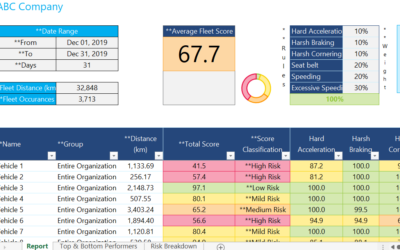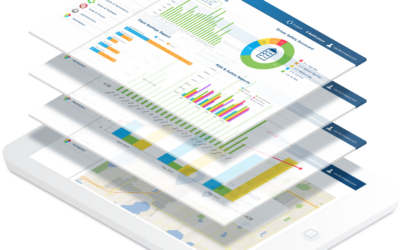ROI of Fleet Telematics
Gone are the days when fleet telematics involved only GPS tracking and vehicle routing. Today, due to immense innovation, fleet managers can benefit immensely from it. However, despite the promise that telematics brings with it, most fleets are not too keen on using a telematics product.
According to a 2018 survey, only 30% to 40% of fleets were utilizing telematics back then. You’d also be surprised to know that even though it is easily the most basic form of telematics, only 64% of all fleets were using GPS in 2019.
This reluctance toward and aversion of telematics needs to change on a large scale. This is because fleets that are reluctant to use telematics are missing out on various profitable opportunities. With the help of telematics, fleets can run their operations more smoothly and efficiently, generate higher profits, and reduce their costs. This is why, fleet managers, need to present a solid case for telematics and show their fleet company that it can generate maximum return on investment (ROI) for them.
So, if your fleet is reluctant to use telematics, here are 4 ways in which you can highlight fleet telematics ROI:
1. Debunk All of Their Fallacies about Telematics
The first and foremost step is to squash any resistance that your fleet company or leadership might show toward the use of telematics. The best course of action is to understand the cause of this resistance. Here are 3 underlying causes of this opposition and ways to allay them:
Telematics is Expensive
A major reason why fleets don’t use telematics is that they believe the tech is too expensive. However, with the increased production and availability of telematics, its cost has gone down quite a lot in the last few years. Your leadership might argue that it will be expensive when it is fitted in a large number of vehicles. However, this is where the cost-saving nature of telematics comes into the picture (more on this later).
Drivers Feel They Will be Watched and Monitored Continuously
Drivers don’t feel comfortable with telematics and feel that they are being watched and monitored by the “Big Brother” continuously. Invasion of privacy and personal space will always remain an issue. However, it can be dealt with if you simply educate the drivers properly.
Explain to them the data that telematics will help you collect, the way it will be collected, and the purpose behind it. The more honest and upfront you are, the easier it will be for drivers to trust you.
Fleets Believe That They Don’t Need Telematics
Fleets believe telematics won’t help them much due to the way that they use their vehicles. However, the truth is that fleet operations can run much more smoothly and cost-efficiently with the use of telematics.
2. Find Telematics Systems That Match Your Goal
As the manager of your fleet, you must have an acute knowledge of your fleet’s unnecessary expenses and inefficiencies. Use that knowledge to promote the use of telematics that can help you fix those weak points. Create specific targets and goals that telematics can help you achieve and then find the tech and systems that can help you attain them.
For instance, if your goal is to reduce fuel consumption, then find a fleet management system that can track how your vehicle is being used by the driver. It will monitor if your driver is driving too fast, too slow, or idling on the job. It will help you identify where your fuel is being wasted, which will ultimately help you reduce fuel costs.
3. Emphasize the Incredible Advantages of Telematics
Let’s revisit the objection that telematics is expensive. Don’t deny or try to refute the fact that buying a tracking system for 1,000 or so vehicles will be costly. Instead, highlight the cost-effective nature of telematics. Make your leaders see that fleet telematics will be one of the best investments for their company.
The benefits of using telematics easily surpass the upfront costs. According to a survey, fleets that implemented telematics saw an increase in fuel savings, improvement in driver behavior, and enhancement in fleet and driver safety. It also saw a reduction in delivery times, maintenance costs, and emissions. All of these benefits culminated in lower operating costs and higher profits for the company.
If the higher-ups are still reluctant to shell so much money on telematics, then convince them to run a pilot project by installing a telematics system in only a few vehicles. Gather the date from those vehicles and report the generated ROI to the leadership.
4. Make an ROI Measurement Plan
When it comes to measuring the ROI of telematics, you need to have a plan in place. It will help you maintain the quality of your data and avoid various challenges such as inconsistent and irrelevant data. Other challenges that you might face include underutilization of telematics and data that’s unnecessarily complex and too time-consuming to analyze.
To avoid all of these issues, you need to perform due diligence and select a telematics provider with the best and most efficient systems. Do thorough research and ask questions on data relevance, accuracy, complexity, and usefulness. Try to select a telematics provider that will help you create a systematic ROI measurement plan and relate the data gathered from their telematics products to your goals and objectives.
The Bottom Line
For the successful implementation of telematics, you need to convince the higher-ups at your company that it truly is a no-risk investment that will generate maximum ROI for their business. It will lead to better fuel economy, improved driver safety, operational efficiency, and so much more. Address and allay all of their concerns one by one and formulate an ROI measurement plan that will help them see the benefits of fleet telematics.






